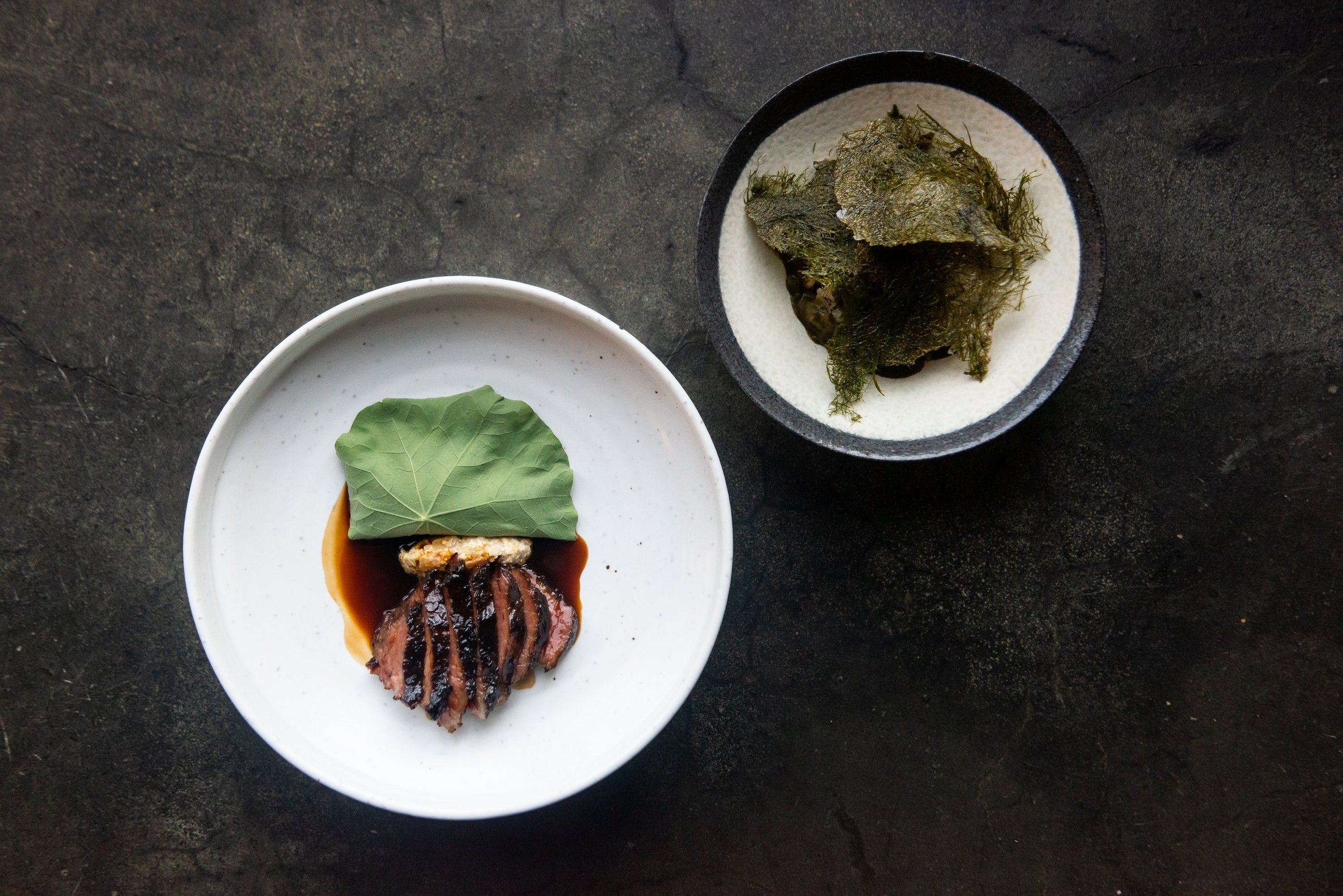Skate Wing Ssam
Breaking down Chef Sky Kim’s showstopping spread at PVD's Gift Horse
photo: will blunt
“I love eating ssam,” says Chef Sky Haneul Kim, rather emphatically. She grew up in her grandmother’s kitchen learning countless pickles, ferments, and dishes, including ssam. “My grandma’s house had a big garden, and she would go out and pick a bunch of lettuce,” she says. “She had a big jar of ssamjang in her backyard—to me, rice, lettuce, and ssamjang is a perfect meal.”
When Chef Ben Sukle tapped Kim to run the kitchen for the group’s new concept Gift Horse, a raw bar and restaurant that highlights local produce and seafood, she looked to her memories to come up with ways to bring in her own style. “In Korea or at Korean restaurants, you’d usually see ssam with pork belly or beef,” she thought. “I had never seen them with fish. I love fried fish, and normally the only crunch in a ssam is the lettuce—they never have that crispy fried texture.
She opted for buttery Rhode Island skate (though this changes seasonally), served with local hearty greens and fresh herbs. The next task was to figure out her banchan, especially in the limited time that the restaurant had to open, as most of her go-to’s take over a year to ferment. Kim leaned on her experience and technique, and developed an array of banchan to serve alongside the fried fish, rice, and greens on a vintage sterling silver platter adorned with crabs. All together, Kim’s skate wing ssam “has everything I need for a complete meal,” she says.“Rice, vegetables, fermented stuff, a nutty sauce—you put everything in one bite. It’s sour, sweet, and rich. It just shines in your mouth.”
Skate Wing
Kim starts with a whole skate that she peels diligently: “Skate skin is super spiky, so you have to be careful.” She scores the thick side, then drops it into an eight percent brine for two hours. After that, the fish is dredged in egg, flour, and panko, and fried for four to six minutes until golden and crisp. Finished with flaky salt, the fried skate wing is full of flavor and texture, and a great base to build the perfect ssam.
Haiga Mai Rice
To Kim, no meal is complete without rice, and for her, a plain bowl of white rice just won’t do. “At home, I’ll make a mix of at least ten different types of rice,” she says. However, trying to keep this consistent in a restaurant setting is difficult, so when Haiga Mai rice—which eats like a happy medium between brown and white rice—from Vermont became available, she jumped at the opportunity. Kim steams the rice, then tops it with a compound butter of caramelized onions, carrots, and garlic. “You can’t go wrong with butter and rice,” says Kim.
Spicy Peanut Ssamjang
“When I was younger, cooking with my grandma, and I saw her ssamjang jar, I would always think, ‘why is there mold on top?’” recounts Kim. “I had no idea, but when I tasted it, it was so great; fermented for two years, and with so much flavor.” Needing to speed up the process without jeopardizing the product, Kim kickstarted the nutty condiment with a fermented peri-peri hot sauce that was in the Oberlin kitchen before Gift Horse opened. She blended the sauce with roasted peanuts, scallions, sesame oil, and “a lot of minced garlic.” Then, for texture, Kim folded in chopped peanuts, scallions, and big chunks of garlic, and let it do its thing for at least a few months. “I like it chunkier. It feels like there’s more love, like it’s home-style.”
Spicy Dried Radish
“We got the radishes last fall when they were sweet and watery,” recalls Kim. She peeled and dehydrated the radishes to preserve them, and when it’s time to use them, she adds them to a mixture of water and fish sauce to plump up. After 20 minutes, Kim introduces them to a marinade of chile flake, fish sauce, sesame seeds, sesame oil, garlic, and plum syrup. “We used to get plums, or maesil in Korean, from my grandma’s tree,” she says.“We’d mix it with sugar, and let it ferment for two years.”The result is a chewy, spicy, funky, and sweet banchan that complements the texture of the fish.
Soy Garlic Pickle
Another one of her grandma’s classic banchan, Kim serves a quick pickled version that still packs quite a punch. She thinly shaves garlic into a mixture of soy sauce, sugar, plum vinegar, and vacuum seals it for at least two weeks before serving.
Black Radish Pickle
When she can find them, Kim likes to use black radishes because of their texture: “The skins have a different texture. Thicker, slightly more bitter, and really pretty.” Kim hot-pickles them simply in plum vinegar, water, salt, and sugar for an additional juicy and salty crunch in her ssam.






